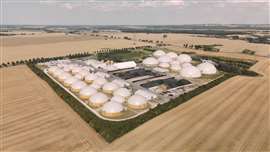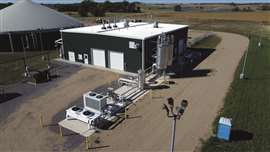RGN company’s push in U.S. market
April 14, 2025
EnviTec said it is well-positioned to expand its biogas processes

EnviTec Biogas AG, Germany’s largest biogas producer, is making a push into the U.S. market, leveraging its 23 years of expertise in transforming poultry manure into renewable natural gas (RNG), bio-Liquefied Natural Gas (LNG), and other sustainable energy solutions.
With an increasing global demand for renewable energy and waste-to-energy technologies, EnviTec said it is well-positioned to expand its biogas processes to address environmental and economic challenges in the U.S. poultry industry.
The company attributes its success in the biogas industry to CEO Olaf von Lehmden. With his deep expertise in the poultry sector—overseeing the production of 7.5 million eggs per day through ventures such as EiPro and Deutsche Frühstücksei—von Lehmden recognized the challenges of managing the substantial waste generated by poultry operations. His solution: EnviTec Biogas, a company that transforms poultry waste into valuable biogas, reducing the environmental impact of chicken farming while generating clean energy.
EnviTec’s process involves anaerobic digestion (AD), where poultry manure is broken down in sealed environments to produce biogas. This process not only helps reduce greenhouse gas emissions but also produces valuable by-products, such as RNG and nutrient-rich compost. By tapping into the vast amounts of poultry manure produced globally, EnviTec has created a sustainable and scalable solution for converting agricultural waste into renewable energy.

As the company looks to expand its operations to the U.S., the market potential for poultry waste-to-energy solutions is substantial. According to Timothy Logan, President of EnviTec Biogas Construction, the U.S. market for chicken manure biogas is underdeveloped, even though poultry manure is already a valuable fertilizer. This has led to slower adoption of AD plants in the U.S. compared to dairy manure, which is more easily digestible and more quickly turned into biogas, the company said. However, with over 30 million tons of broiler and layer manure generated annually in the U.S., the opportunity for biogas production is massive. Research suggests this could yield over 400 million British thermal units (mmBtu) per day, which is enough to meet the heating needs of approximately 3.7 million homes.
EnviTec’s expertise in managing poultry manure through anaerobic digestion positions the company to capitalize on this potential. Stefan Dehne, General Manager of EnviTec Biogas Construction, said the U.S. is poised to see significant growth in biogas plants that utilize poultry waste. EnviTec’s efforts to develop several projects in the U.S. market are already underway, with a focus on designing sustainable and profitable systems for local farmers and energy producers. However, Dehne emphasizes that successful implementation requires careful planning and accurate data to ensure financial and operational viability. The company said it is dedicated to developing realistic, repeatable, and defensible project plans, with a strong emphasis on ensuring that both feedstock mass balances and revenue streams are fully vetted before moving forward.
Logan, who is based in the U.S., is optimistic about the potential for EnviTec’s advanced technologies to enhance the U.S. market. In particular, the company’s integration of ammonia stripping technology, already successful in Germany, offers the possibility of producing ammonium sulfate—a valuable by-product—while also reducing water usage in the digestion process. This innovation, combined with the production of RNG and nutrient-rich compost from poultry manure, creates an attractive economic model for biogas production in the U.S.
One of EnviTec’s most successful projects is the Güstrow biogas plant, which processes over 110,000 tons of chicken manure annually. In 2021, EnviTec acquired and retrofitted the plant, turning it into Germany’s largest fully integrated bio-LNG liquefaction facility. At Güstrow, biogas is upgraded through advanced membrane technology to RNG and compressed into LNG. The CO2-rich off-gas is also captured and refined into liquefied CO2 (LCO2). By introducing ammonia scrubbing technology, EnviTec is expanding the plant’s revenue streams while also improving the efficiency of the anaerobic digestion process.
COMPRESSORTech2 spoke with Logan about the company and the RNG market.
Company Expansion Strategy
EnviTec Biogas has recently expanded its operations in Germany with significant investments. Can you tell us what prompted the decision to expand to the U.S. market now?
We’ve actually had a presence in the U.S. since 2010. Our U.S. story is neatly summarized here. As you can see, early on we won some awards with the American Biogas Council for our co-digestion designs. Our projects were at that time realized through NYSEG grants for renewable power production, so we had smaller plant concepts delivered with CHPs.
What specific market needs or opportunities in the U.S. are driving your decision to expand?
Our growth in the U.S. since 2021 has been driven primarily by the Renewable Fuel Standards and the California Low Carbon Fuel Standard. These programs, when combined, spurred significant development and new projects for us across the dairy sector.
What challenges did EnviTec Biogas face when considering the U.S. market compared to your operations in Europe?
The initial challenges for us were dealing with very tight construction timelines and conformance to local norms, standards and codes. Now, as a slightly more mature business in the U.S., we are continuing to focus on our long-term growth strategy that includes aftermarket sales and support, i.e. service. Of the 750+ plants EnviTec has commissioned since 2002, less than 20 of those have operated on a monoslurry of cow manure. Thus, we are focused on bringing more of our experience regarding co-digestion and more challenging feedstocks to the U.S. market.
Can you walk us through the steps you took to assess the U.S. market before making this decision? Were there any particular regions or states that stood out for your expansion plans?
We studied the market a little over four years ago, and what stood out to us was the dairy market, food waste and landfills. Therefore, our focus was on regions with a high population of dairy. Of course, we were following developers and owners in this pursuit, as we do not originate projects in the U.S.. So, we ended up getting very busy with the dairy market, expanding our local staff and sub-suppliers, and made strategic investments in office and warehouse facilities to strengthen our physical presence in key areas where we were initially successful. This, in turn, has further extended our reach across the U.S.

Technological and Operational Insights
Your company has made impressive upgrades to your plants in Germany, particularly in Forst and Friedland. Will these same technologies and systems be replicated in your U.S. facilities?
It’s an interesting question. Generally speaking, in Germany across our own plant portfolio, investments have been made to change from CHP to gas upgrading (EnviThan) and liquified CO2. This is a combination of expiring PPAs and a shift in RED II to place increased value on energy from waste streams such as chicken manure. For existing plants that have been built recently in the U.S., upgrades we are anticipating include expansion of the existing dairy herd sizes, which would require increased in digestion and gas upgrading capacity. Additionally, some sites may explore liquified CO2 as an additional revenue stream. Our older plants are now contemplating larger maintenance projects, such as roof replacements, which come with their own unique challenges and execution strategies.
Could you elaborate on the bio-LNG and biomethane technologies that EnviTec Biogas has developed and how they will be applied in the U.S.?
As far as biomethane goes, EnviTec Biogas was the first OEM for Evonik Industries. Early on, Evonik held the patent for the 3-stage upgrading system, but money to commercialize this patent was scarce as it was not well understood and had not been built at an industrial scale. At this time, EnviTec had less than desirable outcomes with other treatment technologies outside of traditional CHP in order to upgrade biogas to biomethane. This was the beginning of the collaboration between Evonik and EnviTec. The first plant that commercialized the Evonik patent was Sachsendorf which was commissioned in 2012. We have since commissioned over 100 such plants and still have a unique R&D relationship with Evonik.
In the U.S., the future of bio-LNG is less certain, because of the various incentive structures in play as well as the improvements and widespread adoption of CNG burning engines for heavy duty transportation. LNG fired engines are simply more common in the EU, so we expect CNG/RNG to remain a strong foothold in the U.S.. What is increasingly interesting is the potential for LNG molecules to flow more to the EU via LNG terminals. This could lead to the environmental attributes associated with LNG molecules moving as well, potentially driving a larger market here stateside.
With the expansion of your gas upgrading capacity in Brandenburg, are there any innovations in plant design or operations that you plan to incorporate into your U.S. facilities?
We are currently in discussion regarding the expansion of a plant completed in 2023 to include a third digester to support the expansion of the dairy herd. This will also involve expansion of the gas upgrading system for biomethane. Additionally, in the U.S. we are excited to implement our EnviTec SCADA and HMI through EnviTec Remote. This is a SCADA and HMI platform designed entirely by EnviTec, with the biogas operator in mind. The amount of data, tag and operating state knowledge, along with permissive and historical trends that can be called up directly through this program are very compelling for supporting local operators.
In terms of biomethane production, can we expect similar production volumes and energy outputs in the U.S. as in your German facilities, or will it be tailored to local demand?
Generally everything is tailored to local demand. Currently, the demand for ultra-low CI gas that was previously traded into California as part of California’s Low Carbon Fuel Standard is low, as that market is oversupplied. This seems to have affected other types of anaerobic digestion plants with different feedstocks, so we’re seeing different agricultural feedstocks such as food, feedlot, and poultry manures come into focus. Each of these plant concepts have different economic and technical considerations. On a per-unit basis, these feedstocks generate more gas than dairy manure, but economic constraints have largely slowed the development of these plants in the U.S. Said another way, the dairy AD success story in the U.S. has gone a long way to mitigate the production of methane.
Environmental and Regulatory Considerations
Climate neutrality in the transport sector is a key part of your strategy. How do you see the role of biomethane and bio-LNG in the U.S. transition to cleaner fuels, especially in the heavy-duty transport sector?
We see it as an immediate solution to this sector to reduce carbon emissions, while also taking advantage of existing natural gas infrastructure.
The U.S. has a variety of state and federal regulations related to renewable energy. What steps is EnviTec taking to ensure compliance with these regulations, particularly in terms of environmental standards and biofuel certification?
Conformance is paramount to everything we do. Projects are accredited by investment grade third parties and we conform to standards to ensure transparency and environmental accountability.
What role do you expect government incentives or policy support to play in your U.S. expansion? How do you plan to navigate the evolving regulatory landscape?
Government incentives and policies certainly play an important role the expansion of the biogas/RNG U.S. market. For instance, many in the industry are currently studying the effects that the Clean Hydrogen Production Tax Credit could have on the industry. To navigate policy and regulatory changes we will strive to diversify our project portfolio, and actively monitor these developments through our relationships with regulatory market experts.
Market Dynamics and Future Prospects
Given the growing demand for green energy, particularly biomethane and CO2, how do you see the future of these markets evolving in the U.S.?
For the RNG market, the amount of opportunities will continue to increase over time, and the basis of the opportunities will diversify. While initial biogas development for EnviTec was soley based on dairy manure, we are seeing increased demand for energy production from food waste, chicken manure, and industrial waste. As the market matures, and project models become more familiar and easier to finance, we anticipate the CO2 market to accelerate. As a supplementary income stream, the liquid CO2 can make certain projects very attractive, as well as further reducing the CI score.
What kind of partnerships or collaborations do you envision as crucial for your success in the U.S. market? Are you looking at local partnerships, investments, or acquisitions?
In the past four years we’ve worked strategically on shifting our sourcing to more U.S. based manufacturing and suppliers. The IRA has accelerated this a bit, but our model of growing and developing with local partnerships was always in our DNA. This is a critical consideration for after market sales and support as well. In the near term we are working to build out our relationships for balance of plant engineering and turnkey construction. Our investments have been focused on human resources and office/warehouse infrastructure. We have recently made a large acquisition of fueling infrastructure in the EU, as well and making investments into our Own Plant portfolio.
How does EnviTec Biogas plan to scale its operations in the U.S. to meet the demand for both biomethane and CO2, especially considering the production capacity you’ve developed in Germany?
We will continue to grow our presence in the U.S. to support the growth of the market in the U.S.
Long-term Vision
Looking ahead, how does the U.S. market fit into EnviTec Biogas’s broader global strategy? The U.S. is a fundamental element of the EnviTec Biogas AG growth strategy. Comparatively speaking we have2,250 biogas plants in the U.S., whereas the EU has approximately 20,000 plants in a landmass that is 55% smaller.
What are your long-term goals for the U.S. market, and how do you plan to stay competitive as the market for renewable energy solutions continues to grow?
Long term, we believe in the power of anaerobic digestion to break down organic materials to create beneficial products. Early days, this was contemplated as mostly heat or electricity, and then next up was RNG. Now, we see more and more there’s a better story to tell, more comprehensive plant concepts that really drive the circular economy and there are many improvements – capturing and liquifying CO2, fertilizer recovery, scaling, operations.
Final Thoughts
Are there any upcoming developments or innovations that you’re particularly excited about as EnviTec continues its global expansion?
Larger EnviThan plant concepts that better fit the U.S. market, more and more equipment supply coming from the U.S. market, developing our in house liquid CO2 department, EnviTec remote and related SCADA/HMI improvements to ease operations, and contemplation of both operations and investments in the U.S..
What message would you like to share with U.S. stakeholders, including potential customers, investors, and partners, about EnviTec Biogas’s commitment to the renewable energy sector?
I would say we have a very conservative, long-term view of the market. We have shown ourselves to be adept at designing a plant concept that works in all parts of the world with a wide range of feedstocks. We engineer and build as if we were going to operate the plant, leveraging our 23 years of operational experience to provide tailored concepts that help owners get the most from their investments, over the longest period of time. Sure, building a plant is fun and challenging, but what’s most satisfying for our owners is that they can squeeze that last bit of performance or lower their costs to produce, over the long haul. We are ultra focused on the details, identifying and avoiding risks, and appreciate challenges.
MAGAZINE
NEWSLETTER

CONNECT WITH THE TEAM







